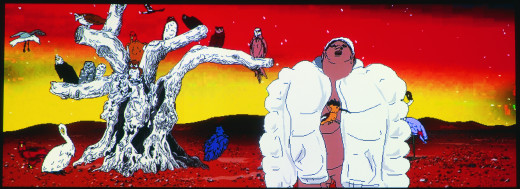Discussing the work of Paul Chan

Discussing the Work of Paul Chan
essay by dayna doria
I would like to combine several theories and topics discussed in recent readings.
Please pardon my inclination to jump around.
I am enthralled by the interconnectedness of past and present in current culture. It seems as though history has lost its chronology, as events from other (previously untouchable) times have become easily accessible. Interconnectedness occurs within individual life times, as well as, historical. The inescapability of one’s past comes with great responsibility, association, and upkeep. A burden that may not be escaped by any other means than isolation or desensitization.
Paul Chan describes this phenomena as the ‘burden of connectedness.’ As both an artist and political activist, Chan combines theme and media to produce powerful images. Images that, most certainly, reflect current times.
Chan references iconographic subjects within his work. Subject matter used includes, but is not limited to; Malcolm X, Baghdad, news & media, Henry Darger/ Netflix, Biggie Smalls, and Pasolini.
Paul Chan uses the adaptation of known subjects to influence understanding. Without a word, without his titles, his work reads as ‘charged.’
I would like to now mention Vilhem Flusser’s Vampyrotheuthis Infernalis. Vampyrotheuthis Infernalis is the philosophical fable of the Vampire Squid. The fable compares the behaviors of the human condition to that of the Vampire Squid. Processing and reaction concerning external information, specifically in the ability of the Vampire Squid to alter its skin, mimics both photographic paper (media reference) and the human mind (social reference). The Vampire Squid conforms by changing its outer skin in an effort to ‘fit in’ with its surroundings. This is not unlike the behaviors of a human within social structures.
In addition to content, Chan’s work is well matured in aesthetic value. By combining traditional forms of art, such as drawing, with ‘new’ tools, such as animation, Chan again acknowledges the interconnectedness of past and present.
In a recent class we discussed Longing for Lightness and Spring, written by Rendell. Within this text, Rendell describes the connection between viewer and work, specifically the personal associations made from emotionally charged subject matter. I find most intriguing the present reaction to memory (past experience), and the trauma/ surprise associated with such experience. Perhaps this explains why when viewing Chan’s First Light, 2005, much of the class associated the falling shadows with memories of 9/11.
Like current media, specifically the internet, photographs exist between the past, future, and present. A photograph maintains its meaning within each of these times, but most fascinatingly is able to transcend time altogether. As tools of perception, photographs are both permanent and impermanent, like that of the vampire squid’s changing skin and that of the ever changing cultural &social structures.
Paul chan discusses the burden that current culture and societal structures put on the shoulders of the individual. It seems peace of mind is unlikely as the mind is rarely able to rest. The amount of associations possible within the work of Chan and consideration of aesthetic principles reflects well the state of current culture, making the work highly valuable as a work of art and historical form.
In lieu of my short comings, I would like to offer the words of a wise dude.
“ You have to escape in order to grow.”
- Paul Chan
PPS: The same wise dude quoting another wise dude.
“ Being poetic and allusive are only two strategies in a menagerie of strategies and methods for art to estrange us from ourselves so we can imagine things outside of us, which is the first step toward empathy, and to learn that we’re not Masters of the Universe. There are so many other strategies. Kafka’s quote about his own work is relevant here. He says that his stories should work like an ice ax breaking the frozen sea within us. Because we have to survive, we preserve ourselves, freeze ourselves, and his stories are a way to break us loose again. It is a brutal exercise in hope.”
- Kafka via Paul Chan



